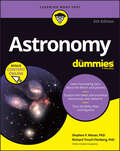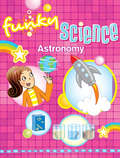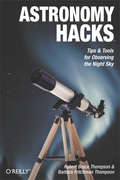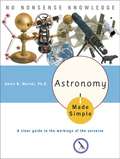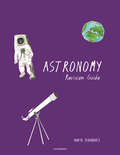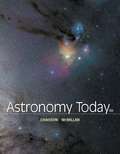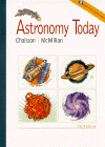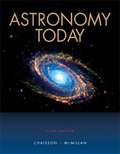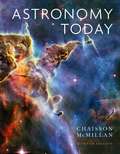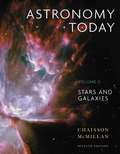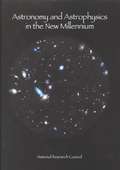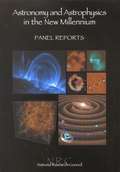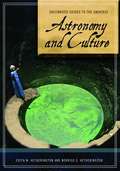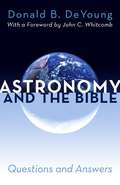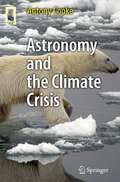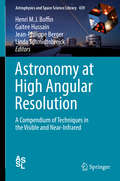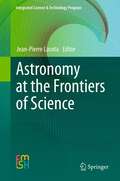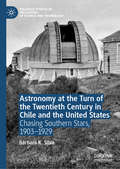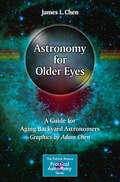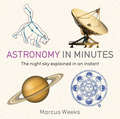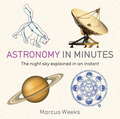- Table View
- List View
Astronomy For Dummies (+ Chapter Quizzes Online)
by Stephen P. Maran Richard Tresch FienbergEmbark on your own personal journey into the night sky. Stardate: Today! Ever catch yourself staring up at the night sky and wondering just what the heck is out there? While no one book can answer all your questions, Astronomy For Dummies will take you on a tour through the Milky Way (and beyond!) that describes some of the most fascinating objects in the universe. This book comes complete with online access to chapter quizzes and downloadable full-color astronomical photos of our universe, as well as easy-to-follow explanations of the eye-popping wonders and gorgeous interstellar objects that populate our solar system, galaxy, and universe. You’ll find: Brand-new star charts for the northern and southern hemispheres, as well as descriptions of the latest tech tools for amateur astronomers Lists of the most recently discovered exoplanets, exomoons, and exocomets hurtling through the cosmos The latest timelines for dazzling solar events and maps to the best places to see them live and in-personFilled with discussions of the biggest and greatest new breakthroughs and an 8-page color insert packed with unbelievable, full-color photographs, Astronomy For Dummies is a can’t-miss book that will ignite a passion for understanding the mysteries of the universe in children and adults alike!
Astronomy Funky Science (Funky Science)
by Kirsten HallSmart and savvy girls will love discovering the secrets of science! Funky Science: Astronomy has loads of cool, creative experiments presented in a fun and accessible way, relating to topics that girls love. Catch up with the stars, discover the secrets of the solar system, live like a space girl, and get groovy with gravity: the universe is yours to explore with the wonders of Astronomy! All experiments are developed with science teachers and provide the science behind the activity along with parental guidance symbols and glossaries of Wonder Words.
Astronomy Hacks: Tips and Tools for Observing the Night Sky
by Robert Bruce Thompson Barbara Fritchman ThompsonWhy use the traditional approach to study the stars when you can turn computers, handheld devices, and telescopes into out-of-this-world stargazing tools? Whether you're a first timer or an advanced hobbyist, you'll find Astronomy Hacks both useful and fun. From upgrading your optical finder to photographing stars, this book is the perfect cosmic companion.This handy field guide covers the basics of observing, and what you need to know about tweaking, tuning, adjusting, and tricking out a 'scope. Expect priceless tips and tools for using a Dobsonian Telescope, the large-aperture telescope you can inexpensively build in your garage. Get advice on protocols involved with using electronics including in dark places without ruining the party.Astronomy Hacks begins the space exploration by getting you set up with the right equipment for observing and admiring the stars in an urban setting. Along for the trip are first rate tips for making most of observations. The hacks show you how to:Dark-Adapt Your Notebook ComputerChoose the Best BinocularClean Your Eyepieces and Lenses SafelyUpgrade Your Optical FinderPhotograph the Stars with Basic EquipmentThe O'Reilly Hacks series has reclaimed the term "hacking" to mean innovating, unearthing, and creating shortcuts, gizmos, and gears. With these hacks, you don't dream it-you do it--and Astronomy Hacks brings space dreams to life. The book is essential for anyone who wants to get the most out of an evening under the stars and have memorable celestial adventures.
Astronomy Made Simple: A Clear Guide to the Workings of the Universe (Made Simple)
by Kevin B. Marvel Ph.D.See the skies in a whole new light. Take a tour of the universe, from our local solar system to the far reaches of deepest space. Astronomy Made Simple offers a complete introduction to this science, from its birth in ancient times to the different types of super-powerful telescopes scientists use today. It also includes detailed instructions on how to map the stars and understand the coordinate system, as well as fun sidebars, ideas for projects for further learning, and resources for the student or the amateur astronomer.
Astronomy Methods
by Hale BradtAstronomy Methods is an introduction to the basic practical tools, methods and phenomena that underlie quantitative astronomy. Taking a technical approach, the author covers a rich diversity of topics across all branches of astronomy, from radio to gamma-ray wavelengths. Topics include the quantitative aspects of the electromagnetic spectrum, atmospheric and interstellar absorption, telescopes in all wavebands, interferometry, adaptive optics, the transport of radiation through matter to form spectral lines, and neutrino and gravitational-wave astronomy. Clear, systematic presentations of the topics are accompanied by diagrams and problem sets. Written for undergraduates and graduate students, this book contains a wealth of information that is required for the practice and study of quantitative and analytical astronomy and astrophysics.
Astronomy Revision Guide
by Marta FernándezDéjate guiar para entender el universo. Pequeño libro de Astronomía para estudiantes de los primeros cursos de secundaria del sistema británico. Aprende sobre el universo a la vez que aprendes inglés. Se trata de un material didáctico y artesanal, lleno de inspiración y de ganas de aprender.
Astronomy Today
by Eric Chaisson Steve McMillanWith Astronomy Today, Eighth Edition, trusted authors Eric Chaisson and Steve McMillan communicate their excitement about astronomy and awaken you to the universe around you. The text emphasizes critical thinking and visualization, and it focuses on the process of scientific discovery, making “how we know what we know” an integral part of the text. The revised edition has been thoroughly updated with the latest astronomical discoveries and theories, and it has been streamlined to keep you focused on the essentials and to develop an understanding of the “big picture.” <P><P> Alternate Versions <P><P> Astronomy Today, Volume 1: The Solar System, Seventh Edition—Focuses primarily on planetary coverage for a 1-term course. Includes Chapters 1-16, 28. <P><P>Astronomy Today, Volume 2: Stars and Galaxies, Seventh Edition—Focuses primarily on stars and stellar evolution for a 1-term course. Includes Chapters 1-5 and 16-28.
Astronomy Today (3rd edition)
by Eric Chaisson Steve McmillanThis textbook is suitable for a college undergraduate survey for non-majors.
Astronomy Today (Fifth Edition)
by Eric Chaisson Steve McMillanFor one- or two-semester introductory courses in astronomy. Chaisson/McMillan is a trusted text that offers the most complete and innovative learning package available for introductory astronomy. The goal of the Fifth Edition is to focus on the process of discovery and to better convey how science is done. Particular attention was given to clearly and concisely presenting scientific terms to the non-science student. Volume 1 includes Chapters 1-16, plus chapter 28. Volume 2 includes Chapters 1-5 plus 16-28.
Astronomy Today, Volume 1: The Solar System (7th edition)
by Eric Chaisson Steve McmillanWith Astronomy Today, Seventh Edition, trusted authors Eric Chaisson and Steve McMillan communicate their excitement about astronomy and awaken you to the universe around you. The text emphasizes critical thinking and visualization, and it focuses on the process of scientific discovery, making "how we know what we know" an integral part of the text. The revised edition has been thoroughly updated with the latest astronomical discoveries and theories, and it has been streamlined to keep you focused on the essentials and to develop an understanding of the "big picture."
Astronomy Today: Stars and Galaxies (7th Edition)
by Eric Chaisson Steve McmillanIn this book, the authors Eric Chaisson and Steve McMillan communicate their excitement about astronomy and awaken you to the universe around you. The text emphasizes critical thinking and visualization, and it focuses on the process of scientific discovery, making "how we know what we know" an integral part of the text. The revised edition has been thoroughly updated with the latest astronomical discoveries and theories.
Astronomy and Astrophysics in the New Millennium
by Astronomy Astrophysics Survey CommitteeIn this new book, a distinguished panel makes recommendations for the nation's programs in astronomy and astrophysics, including a number of new initiatives for observing the universe. With the goal of optimum value, the recommendations address the role of federal research agencies, allocation of funding, training for scientists, competition and collaboration among space facilities, and much more.The book identifies the most pressing science questions and explains how specific efforts, from the Next Generation Space Telescope to theoretical studies, will help reveal the answers. Discussions of how emerging information technologies can help scientists make sense of the wealth of data available are also included.Astronomy has significant impact on science in general as well as on public imagination. The committee discusses how to integrate astronomical discoveries into our education system and our national life.In preparing the New Millennium report, the AASC made use of a series of http://www.nap.edu/catalog/9840.htmlpanel reports that address various aspects of ground- and space-based astronomy and astrophysics. These reports provide in-depth technical detail. http://www.nap.edu/catalog/10314.htmlAstronomy and Astrophysics in the New Millenium: An Overview summarizes the science goals and recommended initiatives in a short, richly illustrated, non-technical booklet.
Astronomy and Astrophysics in the New Millennium
by National Research CouncilIn this new book, a distinguished panel makes recommendations for the nation's programs in astronomy and astrophysics, including a number of new initiatives for observing the universe. With the goal of optimum value, the recommendations address the role of federal research agencies, allocation of funding, training for scientists, competition and collaboration among space facilities, and much more.The book identifies the most pressing science questions and explains how specific efforts, from the Next Generation Space Telescope to theoretical studies, will help reveal the answers. Discussions of how emerging information technologies can help scientists make sense of the wealth of data available are also included.Astronomy has significant impact on science in general as well as on public imagination. The committee discusses how to integrate astronomical discoveries into our education system and our national life.In preparing the New Millennium report, the AASC made use of a series of http://www.nap.edu/catalog/9840.htmlpanel reports that address various aspects of ground- and space-based astronomy and astrophysics. These reports provide in-depth technical detail. http://www.nap.edu/catalog/10314.htmlAstronomy and Astrophysics in the New Millenium: An Overview summarizes the science goals and recommended initiatives in a short, richly illustrated, non-technical booklet.
Astronomy and Astrophysics in the New Millennium: Panel Reports
by Astronomy Astrophysics Survey CommitteeIn preparing the report, http://www.nap.edu/catalog/9839.htmlAstronomy and Astrophysics in the New Millenium , the AASC made use of a series of panel reports that address various aspects of ground- and space-based astronomy and astrophysics. These reports provide in-depth technical detail. http://www.nap.edu/catalog/10314.htmlAstronomy and Astrophysics in the New Millenium: An Overview summarizes the science goals and recommended initiatives in a short, richly illustrated, non-technical booklet.
Astronomy and Culture
by Edith W. Hetherington Norriss S. HetheringtonE. Hetherington, a former second language teacher and attorney, has paired with N. Hetherington (director, Institute for the History of Astronomy) to explore the relationship between astronomy and culture throughout history in the face of contradictory attitudes from the scientific community. This book introduces the discipline of archaeoastronomy to students and scholars by reviewing ancient mythologies about the universe, revealing Babylonian concepts of astronomy, charting the development of calendars and documenting the Copernican and Newtonian Revolutions. The authors also discuss the precarious relationship between religion and astronomy such as the debate between creationism and evolution. Annotation ©2009 Book News, Inc., Portland, OR (booknews.com)
Astronomy and the Bible: Questinons and Answers
by Donald B. DeYoung John C. WhitcombAstronomy and the Bible is a 155-page paperback which answers 100 intriguing questions about astronomy and science. Written by Grace College professor Dr. Don B. DeYoung, it is subtitled Questions and Answers. The questions range across subjects such as the earth and the moon, the solar system, the stars, galaxies and the universe, and general science. Published by BMH Books, Winona Lake, Ind., the book includes a new, helpful series of seasonal star charts for the Northern Hemisphere, along with a general and a scripture index. DeYoung, who has taught at Grace College since 1972, is known internationally for his work in creation science. He is president of the Creation Research Society and is the author of 17 books, including Pioneer Explorers of Intelligent Design, also published by BMH books. He and his wife, Sally, are members of the Winona Lake (Ind.) Grace Brethren church. Astronomy and the Bible's question-and-answer format makes it a practical tool for the classroom and home school.
Astronomy and the Climate Crisis (Astronomers' Universe)
by Antony CookeClimate change is acknowledged as being one of the most important areas of research today. Increasing global temperatures will impact all of us to a greater or lesser extent. From the point of view of research it is an enormously important and complex subject. However, little attention is paid to its relationship to astronomy, the sun in particular but not exclusively. Though directed at an astronomically inclined readership, and providing some less well-known astronomically related information, studies and concepts, this book will also appeal to a broader public, who need to understand the subject of climate change and learn of all the various theories and possible solutions.
Astronomy at High Angular Resolution: A Compendium of Techniques in the Visible and Near-Infrared (Astrophysics and Space Science Library #439)
by Henri M. J. Boffin Gaitee Hussain Jean-Philippe Berger Linda SchmidtobreickThis book offers an essential compendium of astronomical high-resolution techniques. Recent years have seen considerable developments in such techniques, which are critical to advances in many areas of astronomy. As reflected in the book, these techniques can be divided into direct methods, interferometry, and reconstruction methods, and can be applied to a huge variety of astrophysical systems, ranging from planets, single stars and binaries to active galactic nuclei, providing angular resolution in the micro- to tens of milliarcsecond scales. Written by experts in their fields, the chapters cover adaptive optics, aperture masking imaging, spectra disentangling, interferometry, lucky imaging, Roche tomography, imaging with interferometry, interferometry of AGN, AGN reverberation mapping, Doppler- and magnetic imaging of stellar surfaces, Doppler tomography, eclipse mapping, Stokes imaging, and stellar tomography. This book is intended to enable a next generation of astronomers to apply high-resolution techniques. It informs readers on how to achieve the best angular resolution in the visible and near-infrared regimes from diffraction-limited to micro-arcsecond scales.
Astronomy at the Frontiers of Science (Integrated Science & Technology Program #1)
by Jean-Pierre LasotaAstronomy is by nature an interdisciplinary activity: it involves mathematics, physics, chemistry and biology. Astronomers use (and often develop) the latest technology, the fastest computers and the most refined software. In this book twenty-two leading scientists from nine countries talk about how astronomy interacts with these other sciences. They describe modern instruments used in astronomy and the relations between astronomy and technology, industry, politics and philosophy. They also discuss what it means to be an astronomer, the history of astronomy, and the place of astronomy in society today.
Astronomy at the Turn of the Twentieth Century in Chile and the United States: Chasing Southern Stars, 1903–1929 (Palgrave Studies in the History of Science and Technology)
by Bárbara K. SilvaThis Palgrave Pivot tells the transnational story of the astronomical observatory in the hills near Santiago, Chile, built in the early twentieth century through the efforts of astronomers from the Lick Observatory in California. Venturing abroad to learn from largely unmapped Southern skies and, hopefully, answer lingering questions about the structure of the galaxy, they planned a three-year research expedition—but ended up staying for more than twenty-five years. The history of the Mills Expedition offers a window onto the history of astronomy, the challenges of scientific collaboration across national lines, and the political and cultural contexts of early-twentieth-century Chile and the United States.
Astronomy for Older Eyes: A Guide for Aging Backyard Astronomers (The Patrick Moore Practical Astronomy Series)
by James L. ChenThis book is for the aging amateur astronomy population, including newcomers to astronomy in their retirement and hobbyists who loved peering through a telescope as a child. Whether a novice or an experienced observer, the practice of astronomy differs over the years. This guide will extend the enjoyment of astronomy well into the Golden Years by addressing topics such as eye and overall health issues, recommendations on telescope equipment, and astronomy-related social activities especially suited for seniors. Many Baby-Boomers reaching retirement age are seeking new activities, and amateur astronomy is a perfect fit as a leisure time activity. Established backyard astronomers who began their love of astronomy in their youth, meanwhile, may face many physical and mental challenges in continuing their lifelong hobby as they age beyond their 55th birthdays. That perfect telescope purchased when they were thirty years old now suddenly at sixty years old feels like an immovable object in the living room. The 20/20 eyesight has given way to reading glasses or bifocals. Treasured eyepieces feel all wrong. Growing old is a natural process of life, but astronomy is timeless. With a little knowledge and some lifestyle adjustments, older astronomers can still enjoy backyard observing well into their seventies, eighties and even into their nineties.
Astronomy in Minutes
by Giles SparrowWhat happens when a star dies? How many asteroids are in our solar system? Can galaxies collide? What is dark energy? Astronomy in Minutes answers all these questions and more as it condenses 200 key concepts into easily digestible essays. From Trojan asteroids to stellar black holes, and from superclusters to cosmic microwave background, this book will take you on an essential tour around the universe. Beginning with the specks and constellations that we see in the night sky, and then zooming in on the objects and matter" beyond the naked eye, Astronomy in Minutes draws on established theories and recent research. Each essay is accompanied by an image or a clear diagram to help unravel complex ideas. Beginning with the constellations and finishing with the latest cosmological theories, this is the perfect reference guide to this fascinating subject.Contents include: The celestial sphere, Piscis Austrinus, the Earth-Moon system, Io and Ganymede, Kuiper Belt Objects, Measuring stellar properties, Nuclear fusion, Red and orange dwarfs, Open star clusters, Planetary nebulae, Supernova remnants, Cosmic expansion, Quasars and blazars, Nature of spacetime, Nucleosynthesis and the Anthropic Principle.
Astronomy in Minutes: 200 Key Concepts Explained in an Instant
by Giles SparrowWhat happens when a star dies? How many asteroids are in our solar system? Can galaxies collide? What is dark energy? Astronomy in Minutes answers all these questions and more as it condenses 200 key concepts into easily digestible essays. From Trojan asteroids to stellar black holes, and from superclusters to cosmic microwave background, this book will take you on an essential tour around the universe. Beginning with the specks and constellations that we see in the night sky, and then zooming in on the objects and 'matter' beyond the naked eye, Astronomy in Minutes draws on established theories and recent research. Each essay is accompanied by an image or a clear diagram to help unravel complex ideas. Beginning with the constellations and finishing with the latest cosmological theories, this is the perfect reference guide to this fascinating subject. Contents include: The celestial sphere, Piscis Austrinus, the Earth-Moon system, Io and Ganymede, Kuiper Belt Objects, Measuring stellar properties, Nuclear fusion, Red and orange dwarfs, Open star clusters, Planetary nebulae, Supernova remnants, Cosmic expansion, Quasars and blazars, Nature of spacetime, Nucleosynthesis and the Anthropic Principle.
Astronomy in Minutes: 200 Key Concepts Explained in an Instant (IN MINUTES)
by Giles SparrowWhat happens when a star dies? How many asteroids are in our solar system? Can galaxies collide? What is dark energy? Astronomy in Minutes answers all these questions and more as it condenses 200 key concepts into easily digestible essays. From Trojan asteroids to stellar black holes, and from superclusters to cosmic microwave background, this book will take you on an essential tour around the universe. Beginning with the specks and constellations that we see in the night sky, and then zooming in on the objects and 'matter' beyond the naked eye, Astronomy in Minutes draws on established theories and recent research. Each essay is accompanied by an image or a clear diagram to help unravel complex ideas. Beginning with the constellations and finishing with the latest cosmological theories, this is the perfect reference guide to this fascinating subject. Contents include: The celestial sphere, Piscis Austrinus, the Earth-Moon system, Io and Ganymede, Kuiper Belt Objects, Measuring stellar properties, Nuclear fusion, Red and orange dwarfs, Open star clusters, Planetary nebulae, Supernova remnants, Cosmic expansion, Quasars and blazars, Nature of spacetime, Nucleosynthesis and the Anthropic Principle.
